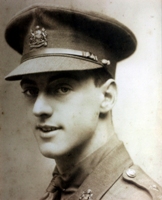
Photograph of William on display in the Museum of the Manchester Regiment. Reference: ASTMR:1997.25.1

(L to R) Distinguished Service Order; Military Cross and two Bars; British War Medal; Allied Victory Medal with 'Mentioned in Despatches' oak leaves
William was born on the 28th December 1894 in Blackburn, Lancashire. He was named after his father William Henry, and his mother was called Mary. He was their oldest child; his siblings were Harry Livesey, Arthur and Nellie. The family were members of the Church of England.
In 1901 the family lived at 30 John Thomas Street in Blackburn. William senior worked as a power loom overlooker in a cotton mill. Ten years later he had been promoted, he was now a weaving manager. We don't know which mill he worked at. William junior worked as a cotton weaver. They lived at 374 Whalley New Road in Blackburn.
William decided he wanted to become a priest. In 1913 he began to study for a Bachelor of Arts degree in Theology at Hatfield College of Durham University. The First World War broke out whilst he was a student, and he spent some time in the University's Officer Training Corps.
William joined the Grenadier Guards on the 15th December 1915. He was given the service number 25406. After training in the UK William was sent to France in August 1916. He was 6 feet tall when he joined the Army.
William joined the 1st Battalion of the Grenadiers. During September they were involved in the Battles of Flers-Courcellette and Morval. We don't know where else William served or how long he spent in France. He was promoted to Lance Corporal during October.
At some point during late 1916 or early 1917 William was selected to train as an officer. He will have returned to the UK and joined an Officer Training Battalion. William was commissioned as a Second Lieutenant in the Manchester Regiment on the 29th May 1917.
Six weeks later he returned to France. William joined the 2nd Battalion of the Manchester Regiment on the 19th July. At this time they were based around Nieuwpoort on the Belgian coast. By February 1918 they were in the front lines around Houthulst Forest near Langemarck. By this time William had been promoted to Acting Captain and given command of a Company.
On the night of the 27th February William led around 110 men on a raid of the German trenches. Raids were carried out to keep the Germans on edge and to obtain intelligence of where their positions were and which units were holding the line. This could be done by capturing prisoners and by bringing back documents and unit badges. Raids were dangerous, small numbers of men without support would be in great danger if they were seen.
William was awarded the Military Cross for his bravery in leading this raid. His citation was published in the London Gazette on the 22nd April:
For conspicuous gallantry and devotion to duty. He reconnoitred the enemy's forward positions in bright moonlight and obtained valuable information. On the following night he led a raiding party into the enemy's line with great gallantry under heavy fire. By his skilful leadership he saved many casualties and inspired all ranks with confidence by his personal example.
The raiders brought back 7 prisoners and 2 machine guns.
On the 17th April William gave up command of a Company and reverted to the rank of Second Lieutenant. By this time the 2nd Battalion was involved in the British attempts to stop the German Spring Offensive. This had begun on the 21st March, and was aimed at winning the war before large numbers of American soldiers could arrive in France. By the middle of the year the advance had been stopped. The British and French began their own offensive on the 8th August.
At some point during this period William was awarded a Bar to his Military Cross. This meant he had carried out another act that was worthy of the medal. He had regained the rank of Acting Captain by this time. His citation was published in the London Gazette on the 11th January 1919. We don't know exactly when or where this deed took place:
For conspicuous gallantry and devotion to duty. During an advance on a village this officer, when the situation was obscure, went along the various companies and gained useful information. He also personally reconnoitred the enemy position under heavy fire, bringing in useful intelligence. Throughout he displayed tireless energy and complete disregard of danger.
The British advance continued into the autumn. By early October they had reached the village of Joncourt. William was awarded a second Bar to his MC during the fighting here. This is his citation, from the London Gazette of the 30th July 1919:
For conspicuous gallantry and devotion to duty at Joncourt on October 2nd 1918. He supervised the forming up of the battalion prior to zero hour under very heavy shell fire, and encouraged the man by his calm and collected manner. Later, when the battalion had suffered very heavy casualties, and the situation was obscure, he went out and reconnoitred the whole line and brought back exact dispositions and valuable information which led to new dispositions being made with a view to holding the line. In the evening he again led forward the ration party to the new line, and it was entirely due to his personal energy and zeal that the rations were delivered intact.
William was not the only officer in the 2nd Battalion to win the Military Cross during the day's fighting. The poet Second Lieutenant Wilfred Owen also received the medal. We don't know how well the two men knew each other.
Wilfred Owen was killed in action on the 4th November. He was killed leading a group of soldiers across the Oise-Sambre Canal at Ors. William was luckier. He survived the fighting and helped the 2nd Battalion cross the canal and advance to their final objective. He was awarded the Distinguished Service Order for his bravery and leadership. His citation was published in the London Gazette of the 10th December 1919:
On 4th November 1918 during the attack on the Oise-Sambre Canal, he displayed marked courage and able leadership when his battalion was temporarily held up. Under intense machine gun fire he went back to Brigade Headquarters and reported the situation. Later, his leadership materially contributed to the success of the day's operations.
The 2nd Battalion was withdrawn from the front on the 6th November. The war ended on the 11th, when they were at Sambreton. They were involved in training and in work behind the lines for the rest of the year. During December they moved to Assesse. The end of the war meant that the Army could begin to demobilise the millions of men serving overseas. This would be a long process, but William seems to have been one of the first to go. He returned to the UK on the 13th January 1919.
William was awarded his degree during 1918. This allowed him to begin his career in the Church of England. During 1919 he was ordained as a Deacon in the parish of Burnley for Manchester. Soon after he moved to Rochdale, Lancashire and became the Curate there. He was ordained as a Priest in 1920.
William stayed in Rochdale until 1922. During this time he returned to the Army. There was a great deal of industrial unrest during this time and widespread strikes were threatened by workers such as miners. The government was afraid that the Police would not be able to cope so it was decided to form an organisation known as The Defence Force. This would be based on the Territorial Army, but separate from it, and used to support the police if a large strike was called. William joined the 6th Battalion of the Lancashire Fusiliers, Defence Force and served as a Captain between April and June 1921. The strikes did not occur, so the Force was disbanded.
Before William left Rochdale, he married Helen Nora Brierley between July and September 1922. She was always known as Nora. They moved to the parish of Elmton with Creswell, near Worksop in Derbyshire, where William had been appointed Vicar.
During their time in Elmton William and Nora had 3 children: Mary C. between April and June 1923, Ursula between October and December 1924 and Helen between July and September 1926. On the 26th April 1923 William returned to the Army. He became a Chaplain to the Forces, 4th Class, in the Territorial Army (TA). This meant William kept his civilian home and job, and mainly carried out his military duties during evenings and weekends.
In 1928 William was appointed to be Rector of Whitwell with Steeley and Rural Dean of Bolsover. This appointment did not last for long, because on the 29th February 1929 William became Vicar of Newark in Nottinghamshire. The parish boundaries were adjusted during 1931 and it was renamed Newark with Codrington. William and Nora's 4th child, Margaret E. was born between April and June 1930 in Newark.
As well as his parish, during 1932 William became Rural Dean of Newark. As Dean he was responsible for looking after the welfare of all the parish priests in his area and keeping them in touch with the local Bishop, the Bishop of Southwell. He also became Honorary Canon of Normandington in Southwell Cathedral.
William returned to Lancashire in 1936. He was appointed Provost and Vicar of the Cathedral Church of Blackburn. He was responsible for the Parish of Blackburn, while the Bishop of Blackburn led the Diocese, made up of several Parishes. He held this job until he retired in 1961. He left the TA on the 23rd January 1939. We don't know whether he rejoined during the Second World War, which broke out that September.
During his time in Blackburn William was keen to see Church Schools succeed and expand. On one occasion he bought an old mill with his own money. This was turned into St Hilda's Secondary School, and later became part of St Wilfrid's Church of England Comprehensive School. This school still exists in 2013; it is called St Wilfrid's Church of England Academy. As William's obituary reported: 'Although he was reimbursed subsequently, without his determination and quick decision and generous spontaneity this school would not have been possible'.
At some point during their retirement William and Nora moved to Brockenhurst, in the middle of the New Forest in Hampshire. They lived at 'Woodruffe' in the village. Nora died there between April and June 1974 at the age of 81. William continued to live there until the 6th January 1980, when he died at the age of 85. His medals came to the Museum of the Manchester Regiment in August 1997.




